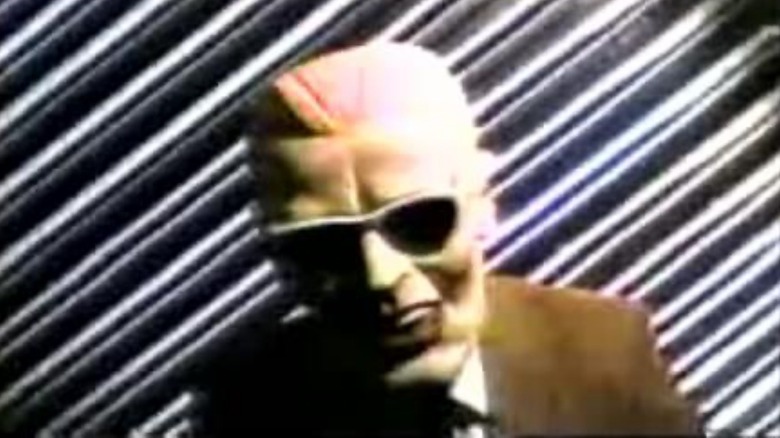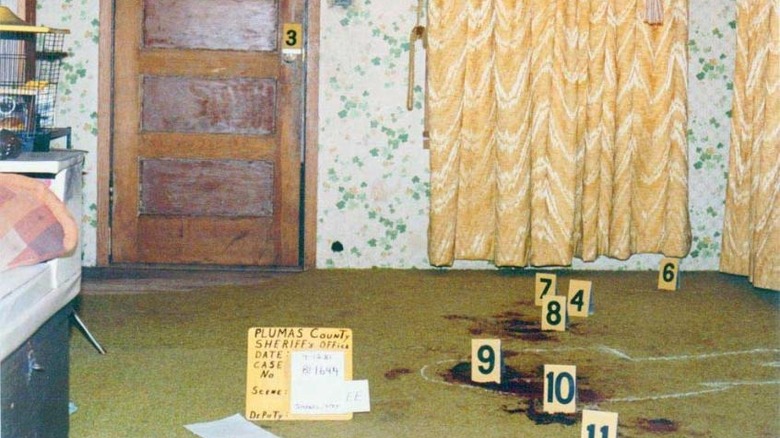The Biggest Unsolved Mysteries Of The 1980s
The 1980s: It was a decade dominated by hair metal, pastels, and a weekly catfight that you knew somehow involved that backbiting so-and-so Alexis Carrington. And while nostalgia for the 1980s is on the uptick, it lionizes the good (as far as pastels can be) and skips over the bad entirely. Like any period of time, there are mysteries unsolved and crimes unpunished. In 2022, it's easy to arrogantly brush this off to police ineptitude or a lack of technology; DNA testing did not exist until 1985 and, according to a Time retrospective, the technology did not result in a conviction until 1987.
Presently, thanks to much-advanced forensic techniques, plus the mass-deployment of CCTV, dash and nanny cams, and the ubiquitous smartphone, law enforcement has more tools than ever before. But it is not to say that investigators were clueless without high-tech gadgetry 40 years ago. As frustrating as it is, cases can be hard to crack, whatever the era, and grow cold.
Read on, and find out what truly, truly outrageous mysteries of the 1980s lived long after the decade died.
The Tylenol Murders
If you ever wondered why over-the-counter medicine is so hard to get into — foil seals, cotton-ball stoppers — it can be traced to one of the most notorious unsolved mysteries in American law enforcement: The Tylenol Murders. PBS documents a series of suspicious deaths occurring in and around Chicago in 1982. Initially, the seven fatalities had no pattern; but autopsies determined that all the victims had taken the popular pain-reliever Tylenol just before they died. Officials, PBS continues, discovered the pills involved had been laced with potassium cyanide.
The CDC lists potassium cyanide as a chemical asphyxiant that can kill with extreme swiftness. At the same time, it is an incredibly adept chemical, with applications in mining, jewelry making, and fumigation.
Drug giant Johnson & Johnson reacted at once, per Crime Museum, releasing a massive public warning, halting production, and yanking 31 million bottles of Tylenol off the shelves. The investigation determined the tampering occurred with pills from different factories and only after they left for sale, but no suspect was ever identified. Ever after, drug-makers safety-proofed their bottles, and Congress made drug tampering a federal offense, but the police remain stymied. The case remains open (via A&E).
Soviet scientist disappears
He was a victim of the Cold War. This is the most plausible theory behind the mystery of Vladimir Alexandrov.
According to an El Pais retrospective, Alexandrov confirmed American hypotheses of a "nuclear winter," a massive global temperature drop stemming from a nuclear war. It turned him into an overnight science superstar, and, unusual for a Soviet scientist at the time, he was allowed extensive international travel privileges to collaborate in the United States and Europe. Things unspooled in 1985, when, El Pais tells, Alexandrov, then 47, traveled to Spain. First giving a talk in Córdoba, he moved on to Madrid, where he had a meeting with Soviet officials. Journalist Andrew Revkin documented that the meeting left the scientist so shaken he got himself even more drunk than usual; El Pais and Revkin confirm Alexandrov was habitually inebriated.
And then Vladimir Alexandrov vanished. No note, no body. After that, El Pais documents how the conspiracy theories proliferated: The KGB killed him for becoming too Americanized; the CIA killed him for being a Soviet spy; he was mugged. Simply, the man disappeared so completely that nothing and everything made sense. The dissolution of the USSR in 1991 led to no opening of records on Alexandrov, and a 2016 article at PulitzerCenter.org concludes Alexandrov is dead. But no one knows for sure.
The Rendlesham Forest Incident
To quote Scientific American, "It's not aliens. In fact, it is never aliens." But no list of unsolved mysteries is complete without them!
Read the BBC article and all the tropes are there: a secluded forest, a military base, lights in the sky, men in suits, the "likely story," and the tabloids — is it any wonder the Rendlesham Forest Incident is the U.K.'s most famous UFO legend? In 1980, American soldiers stationed at RAF Woodbridge reported seeing unidentified lights in the sky descending into the nearby Rendlesham Forest. As another BBC listing describes, the same happened two days later. Afterwards, locals reported a pair of suited men appearing and playing a suspicious game of 20 questions, asking if anyone "had reported seeing" anything.
The incident then slipped into obscurity until three years later when, according to BBC sources, the famously sensational News of the World tabloid ran a story, based on a real USAF document, that a UFO landed in England. The revelation gained more weight when The Guardian reported on Rendlesham in 1985. As the BBC describes, while the locals scoff at the idea and the beam from the Orford Ness Lighthouse was likely the lightsource, why spoil the fun? There is a "UFO trail" at Rendlesham, and the mystery is the source of several books, even a movie. But what exactly happened? No comment.
The drowning of Natalie Wood
Natalie Wood was a Hollywood rarity: a child star who became box-office boffo as an adult, with roles in "Rebel Without A Cause" and "West Side Story." According to IMDb, Wood had, by her death at 43, four Golden Globes wins and three Oscar nominations. But like Marylin Monroe before her, Wood's demise is so fraught with twists, turns, theories, and conspiracies that she is more famous for dying than acting.
The Los Angeles Times lays out the basic facts: in 1981, Wood, her husband, actor Robert Wagner, and their friend, actor Christopher Walken took a nighttime cruise. Wood, who had been drinking and could not swim, vanished. Wagner radioed his wife's disappearance at 1:30 a.m.; her body was recovered later that morning.
Town & Country adds details, stating Wagner found both Wood and the dinghy attached to the yacht missing. The coroner found bruising on Wood's body consistent with a fall and her death was listed as accidental, but the article continues by saying the case was reopened in 2011, and a new witness came forward in 2018. This is on top of a 2012 article in The Guardian highlighting that Wood's cause of death was changed from an accident to "drowning and other undetermined factors," and Wagner is now a "person of interest." But no one is charged, as of yet. 41 years after her death, Natalie Wood is still entertaining.
Max Headroom signal hijacking
On November 22, 1987, Chicago was left bewildered when the nightly news on WGN-TV was suddenly replaced by a figure wearing a Max Headroom mask (via The Verge). (For background, Max Headroom was an icon of the 1980s. The CGI'ed version of actor Matt Frewer, The Verge describes the character as a dystopian, deconstructionist fountainhead against corporate greed.) Cybernews.com describes the event (and includes an actual clip); accompanied by a white-noise whine, the figure remains silent and merely bobs on screen for 25 seconds before station engineers re-established control.
Then it happened again! As Atlas Obscura relates, Chicago-area PBS affiliate WTTW-11 was hacked two hours later by the same figure, who now spoke in a stream-of-consciousness ramble through a voice-distortion effect for two minutes. The article includes the WTTW-11 clip; along with the babbling, "Max Headroom" signed off by giving viewers an eyeful when he mooned the audience and was spanked by a woman with a fly swatter. Yes, really.
"The Max Headroom hack" has gone down in history as one of the most infamous signal piratings in American television, augmented by the fact no one knows who did it — at least, definitively. Atlas Obscura describes how, in 2010, Reddit user "bpoag" went into astonishingly exact detail why the hack was performed: two unnamed techies wanted to demonstrate the vulnerability of American technology. Claims made by bpoag were not confirmed.
Crash of Arrow Flight 1285
248 American soldiers of the 101st Airborne Division (nicknamed the Screaming Eagles) died on December 12, 1985, in Newfoundland, Canada, when their plane, Arrow Flight 1285, fell from the sky and crashed, killing all on board, including the eight crewmembers. A retrospective in the Fort Campbell Courier calls it the "largest single-day tragedy with loss of life in Screaming Eagle history."
Even as families mourned and communities rallied, the Canadian Aviation Safety Board rushed to figure out how the plane, not 1,000 feet off the ground, suddenly crashed. As unknowns go, there is no indication of general maleficence concerning Arrow Flight 1285. Rather, the mystery lies in the lack of a good theory as to what happened that everyone accepts.
Officially, the crash was blamed on ice build-up thanks to the notoriously harsh Newfoundland winter, something the Fort Campbell Courier notes. However, the CBC has an article citing an investigator so unconvinced of those findings that he filed a minority report (think an official disagreement). A similar article at the Cape Cod Times posited an explosion in the cargo hold took Arrow Flight 1285 down. Reports take pains to say the flight originated in the Middle East, giving rise to questions of terrorism (via UPI). So who do you believe?
The killing of Ken Rex McElroy
How does a man get shot dead in broad daylight — a crime witnessed by 60 people — and no one is ever brought to justice?
Ken Rex McElroy terrorized the people of Skidmore, in northwestern Missouri. According to local affiliate Fox 2 (which says "bully" is too kind a term), the man was accused and suspected of "theft, livestock rustling, burglary, arson, assault ... and child molestation." He raped and impregnated a 12-year-old girl, and, to avoid statutory charges, married the child after an intimidation campaign against her parents. As Fox reports, intimidation was how McElroy got away with 20 charges against him going back into the 1970s. Both Mental Floss and Bustle write of the final blow: McElroy successfully, and suspiciously, appealed a murder conviction in July of 1981. Then he died in a hail of bullets.
No one called an ambulance. No one rushed to help. No one came forth. No one saw a thing. The case, and the wall of silence stymieing it, made headlines. As Bustle alleges, McElroy earned the hatred of Skidmore so completely, not only did the entire town conspire to kill him, it refused to point fingers. The New York Times reports witnesses admitting seeing the shooting occur but not the shooter. The same article notes the people of Skidmore have no desire to see the case progress. Now a cold case, this is an example of an intentionally unsolved mystery.
The case of Mr. Cruel
Starting in 1987, an unknown man in a black balaclava started a serial spree of child rapes, assaults, abductions, and at least one murder across the city of Melbourne that has kept Australia on edge ever since. Dubbed "Mr. Cruel" by the press, the police identified only a very basic modus operandi: as one article at News.com observes, each victim was monitored before the attack, and abducted victims were later found by electrical substations, leading to the assumption Mr. Cruel worked for the power authority, but little beyond that. According to archives at the Herald Sun, each attack, at least 12 in all, was meticulous and unhurried. A conscientious and self-aware criminal, he even went so far as to provide false leads. While surviving victims were able to provide some information, the Herald Sun details how each was gagged and carefully blindfolded, limiting their abilities.
And then, in 1991, the attacks stopped, leaving police no closer to solving the case. According to the Herald Sun, seven suspects were identified by law enforcement, but no progress has been made on any. With no new leads, the task force assigned to Mr. Cruel disbanded in 1994 (via All That's Interesting), and, given the time between that year and this, some sources question if Mr. Cruel is still alive.
A creature of the night, Mr. Cruel returned to it, and no one knows if he is still there.
The Vending Machine Murders
A nation where real estate is at a premium, Japan has long relied on more versatile vending machines alongside actual stores for casual purchases. According to Business Insider, the country has a higher density of vending machines than any other, selling everything from sodas to clothes. And they were the apparent focal point of a series of deadly poisonings in Japan in 1985. According to a New York Times article, an unknown perpetrator would buy a soft drink, inject a lethal dose of the herbicide paraquat into the bottle, and then leave it in, on, or near the vending machine. People saw the free soda as a lucky find, only to ingest the chemical. 10 people died, with 35 seriously injured.
No one claimed responsibility and no witnesses came forward. Then the poisonings stopped, and the case screeched to a halt. The New York Times tells how local police surmised it was the work of a "yukaihan," a thrill killer who enjoys toying with victims. And the rest of Japan ... didn't do much.
Bottles were not redesigned, vending machines were not fail-safed. A famously law-abiding society, the Japanese actually blamed the victims for carelessness. The Times goes so far as to say some suspected some of the murders were, in fact, suicides (not an uncommon phenonenon in Japan, according to CNN.) As with many unsolved cases, the killer is still at large.
The vanishing of Cynthia Anderson
Arguably the most famous missing person of the decade, Toledo resident Cynthia Anderson was a stereotypical church-going good girl, who, on an ordinary day in 1981, disappeared into thin air and has neither been seen nor heard from since.
According to the case file with the Ohio Attorney General, Anderson, a legal secretary, had prepared the working day for her superiors. The radio was on, and an unfinished romance novel was on her desk. The Charley Project adds more detail: Anderson's purse and keys were missing, but her locked car was still in the parking lot. There was no sign of a struggle, and the office door was locked. The Toronto Blade notes calls to the office started going unanswered at 10 a.m. Oddly, she had place-marked her book at a scene involving an abduction by knifepoint.
The strongest clue was that Anderson was subject to a series of disturbing phone calls and eerie messages, and Parade recounts the words "I love you, Cindy" — signed by "GW" — had been spray-painted on the opposite wall of her office. This stalking behavior unsettled Anderson so much, an alarm buzzer was installed at her work place. It was never used. Police were stumped. Suspects were pursued, according to The Charley Project, including convicted felons, but to no avail. She was gone. When her father died, the obituary mentioned his daughter predeceased him, but the case remains open.
Keddie Cabin Murders
"I've paid the price of your love & now I've bought it with four people's lives." According to a Plumas County News retrospective from April 2018, that quote, which included a signature, is considered all but a confession to the Keddie Cabin Murders, a brutal family slaying in 1981. Two suspects were even identified. And the case still went cold.
ThoughtCo adds detail: The bodies of Glenna "Sue" Sharp (36), her son John Sharp (15), and his friend Dana Wingate (17) were discovered killed in a cabin in the small northern California community of Keddie. Missing was the Sharp daughter, 12-year-old Tina, whose remains were found in the woods three years later. Found at the scene were the murder weapons and, astonishingly, the three other children who went the entire episode unharmed in another room. Plumas County News has authorities surmising at least two perpetrators, but a piece published a week earlier says as many as six could be involved.
Authorities looked at Martin Smartt, who wrote the quotation, and Severin John Boubede for connections, but as ThoughtCo observes, police infighting and outright bungling froze the case so thoroughly it remains unsolved to this day. The Sacramento Bee noted new technology is shedding new light; however, both Smartt and Boubede have since died, dimming hopes for justice. Perhaps pragmatically, in a 2016 interview with People, survivor Sheila Sharp says she just wants answers.
Body found in a septic tank
Sometimes a criminal case becomes an enduring mystery because the facts seem so ludicrous: as DayDayNews translates, in 1989, the Fukushima prefectural authorities in Japan suspected Naoyuki Kanno died in a ladies room septic tank of hypothermia in a failed attempt to watch women relieve themselves. While this would seem like an extreme Peeping Tom case, the surrounding facts do not add up.
The article recounts how townsfolk immediately came to Kanno's defense when police announced the predatory theory; the man was a father and an apparent pillar of the community. Moreover, no one knows how he got into the tank in the first place. Essentially just a large, C-shaped industrial pipe, the space was so cramped, just 14.17 inches wide and 18.5 inches tall, the 26-year-old Kanno was wedged inside. Indeed, they had to excavate and dismantle the entire unit to extract the body. The article includes a forensic drawing of the scene — Kanno was found on his back in a fetal position, shirtless, holding a neatly folded jacket to his chest, with no tell-tale injuries. He would have been looking up into the urinal (basically a porcelain hole in the floor), and he ultimately ended up freezing to death.
Dissatisfied with the official findings, 4,000 locals demanded the case be re-investigated. However, as no further clues were found and no suspects identified, the case went cold.












